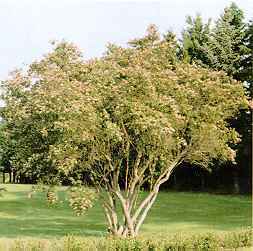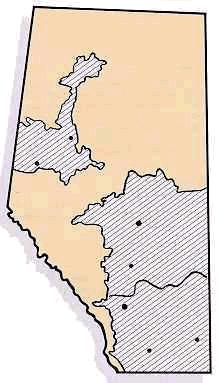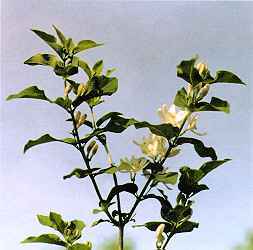| | Plant characteristics | Site preference | Hardiness | Uses | Problems | Diseases | Insects | Pruning
.

Scientific Name: Lonicera tatarica L.
Plant Characteristics
Tatarian honeysuckle originated in Southern Russia and Turkistan. Introduced to North America, now widely distributed throughout Alberta.
This is a fast growing, somewhat leggy tall hedge shrub. It can reach 3 m (10 ft) in height with a 2.5 m (8 ft) spread.
Tatarian honeysuckle can be long lived, 50+ years if properly maintained. Honeysuckle can grow from 10 to 30 cm (4 to 12 in.) per year at an early age.
Leaves - are opposite with smooth edge, leaf surface is a glossy blue green, and a pale green underside, ranging in size from 2 to 8 cm (1 to 4 in.) in length.
Flowers - Flowers are white through pink to a deep red, approximately 1.5 to 2 cm (0.50 to 0.75 in.) long in pairs, two lipped and very numerous. Produced in June.
Fruit - Yellow - orange to red berry, not readily eaten by birds, approximately 4 mm (0.25 in.) in diameter. Fruit matures in July.
Back - Older bark is light brown/grey with a tendency to peel off in long strips. Young twigs are pale yellow and smooth.
Site Preference
Tatarian honeysuckle will tolerate a wide variety of soils, but requires a well drained soil. It has established itself in woodlands and moist spots, but will not tolerate flooding for extensive periods.
Tatarian honeysuckle is drought tolerant. Grows best in full sun, but can tolerate a little shading.
Hardiness
Tatarian honeysuckle is extremely winter hardy; the plant will survive under extreme climate exposure.
.


Uses
The flowers, which occur at the beginning of June, are of ornamental value. It is recommended that honeysuckle be planted with other rows of shelterbelt trees and as a hedge for farmstead shelterbelts. Planting distances within the row are recommended at 1 to 1.5 m (3 to 4.5 ft). It may also be used as single row for fields or roadside.
Problems
Aphids cause a severe problem, making the planting a very messy site.
Diseases
Relatively free of disease.
Insects
Subject to aphids, especially the black or mistletoe aphid, mites and blister beetles. Blister beetles can defoliate honeysuckle within two to three days. Since these beetles are migrating, they are difficult to catch in time.
Pruning
Old stems can be removed at ground level to keep the shelterbelt vigorous.
.

Shelterbelts Varieties for Alberta provides information on a number of other trees and shrubs than may be suitable for shelterbelts.
Visit our website directory for the Reforestation Woodlot Listings.
|
|